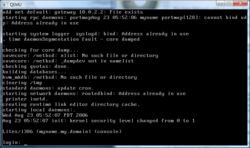Difference between revisions of "Mach"
(filled in some blanks.) |
m |
||
| Line 32: | Line 32: | ||
== Getting it to run == | == Getting it to run == | ||
| − | Installing Mach on the PC is not a task for the timid. It is VERY involved and difficult. I have decided to provide an image [http:// | + | Installing Mach on the PC is not a task for the timid. It is VERY involved and difficult. I have decided to provide an image [http://vpsland.superglobalmegacorp.com/install/MachUK22-lites-nat.zip here]. I may document the install later, but it is extremly complex. |
{{stub}} | {{stub}} | ||
Revision as of 17:02, 14 October 2009
| Mach | |
 Logging into a Mach/Lites/NetBSD system | |
| Type: | Multitasking, multiuser |
|---|---|
| Creator: | CMU |
| Architecture: | m68k, i386, POWER, HPPA, Sparc |
| This Version: | 3.0 (1994) |
| Date Released: | 1985 |
Mach was the microkernel from CMU that popularized the microkernel craze of the late 1980's and into the 1990's. While seen as a dead end effort, it did at the time bring in many new things to the aging Unix kernel. Mach, based loosely on BSD was a low level kernel adding threads insteads of forked processes, and had the ability to run on SMP hardware. BSD was then ported back as a user process ontop of the Mach micro kernel.
Mach Operating Systems
Some of the operating systems that used Mach were NeXTSTEP/OPENSTEP & OSF/1. The GNU Hurd project also used Mach at one point before abandoning it for L4. There was even some 'free' verions of Mach that started to ship after the opening up of the BSD source code.
After 1994 Mach 3.0 was picked up by the University of Utah, who released Mach 4.0, and the OSKit. Then they focused on L4.
The GNU project had taken a version of Mach, and used the GNU license to 'gnu-ify' mach and produce GNUMach. While Windows NT may share design ideas with Mach, it is NOT a derived Mach microkernel.
Servers
Mach could run various 'server' programs that would then provide an operating system personality to the user.
Lites
One of the more popular servers was Lites. It was a BSD based personality that could then run early versions of NetBSD & FreeBSD.
Criticism
Mach was seen as unescesary as it's main idea of running multiple servers hardly ever happened. Most projects based on Mach only ran a single server. Also every time a program made a system call it had to transition through the kernel to talk to the 'server' process, which had to go thru mach again to do whatever it was, then back to the server, then thru mach again to talk to the program. The overhead system call was was signifigant, and a way was never developed to bring the LPC calls down to something comperable to an older monolithic style OS. This is why XNU (the Nextstep/Openstep/Darwin/OSX kernel) used mach as a library rather then as a full blown microkernel.
The rise if Linux also showed that a restructured monolithic kernel could not only scale on SMP hardware, but could remain portable.
Getting it to run
Installing Mach on the PC is not a task for the timid. It is VERY involved and difficult. I have decided to provide an image here. I may document the install later, but it is extremly complex.